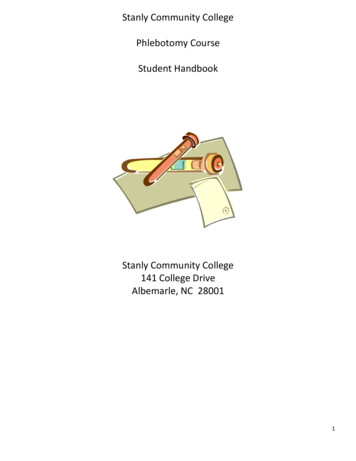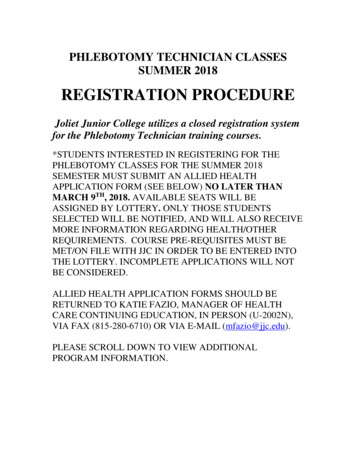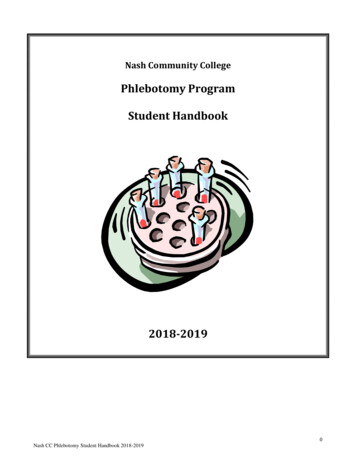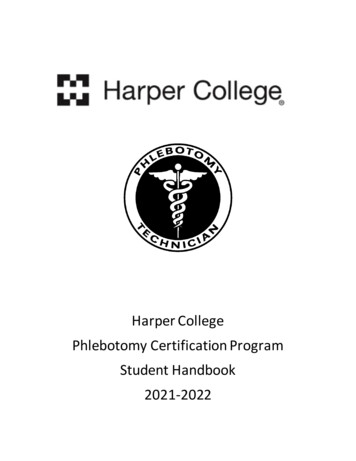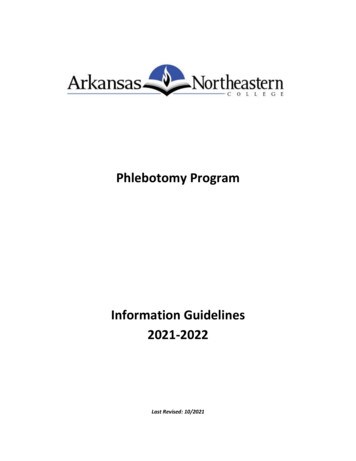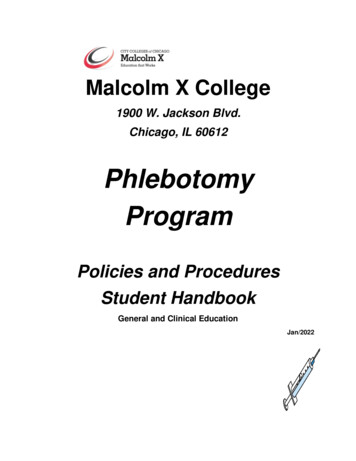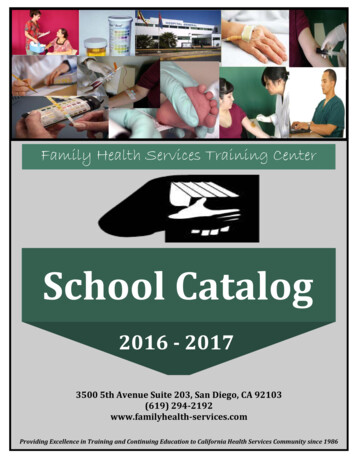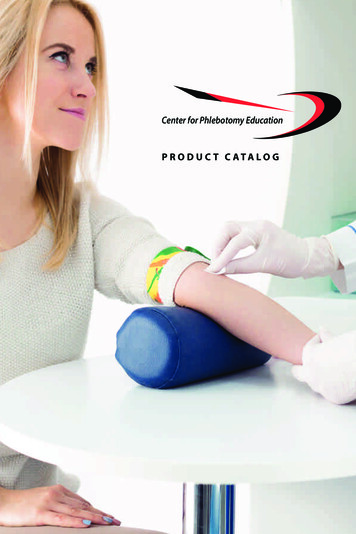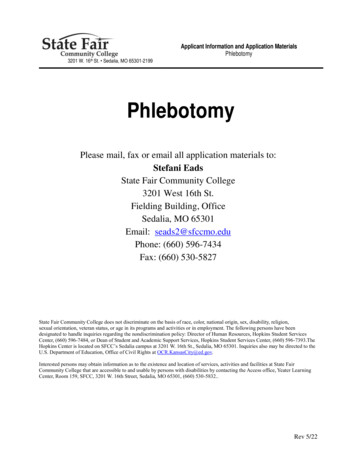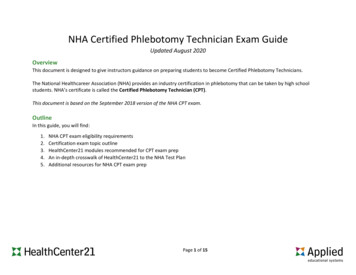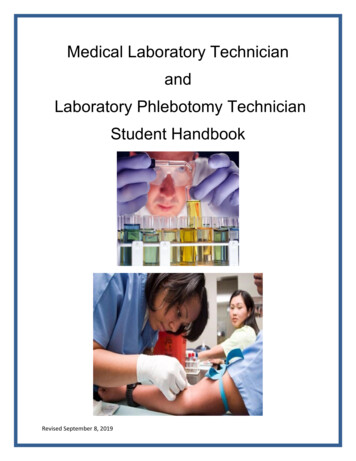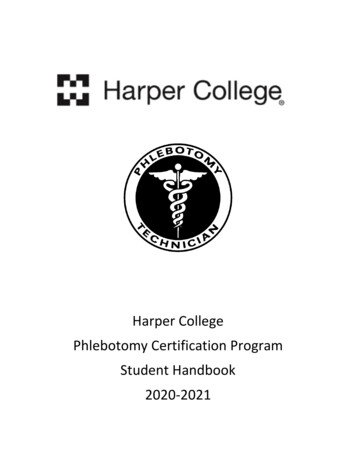
Transcription
Harper CollegePhlebotomy Certification ProgramStudent Handbook2020-2021
Phlebotomy ProgramTABLE OF CONTENTSWelcome . 4Harper College’s Mission, Vision, Philosophy and CoreValues .5Phlebotomy Program Mission Statement . 6Phlebotomy program curriculum outline . 7Functional Abilities: Health Sciences Programs . 7-8Student Advising Counselor . 8Phlebotomy 101 Course Description and Objectives . 9Didactic and Psychomotor objectives of PHB 101. 9Phlebotomy 102 Course Description and Objectives . 10-11Didactic and Clinical Objectives of PHB 102 . 10-11Student Records and Advance Placement Policies 12Section 1: Phlebotomy Health Clearance RequirementsHealth Clearance for Phlebotomy . . 13-14Medcom Healthcare Courses . 15Procedure 1A: Phlebotomy 101 Students prior to PHB 102 placement . 16-20Physical Exam. 16Mumps, Rubella, Rubeola, Varicella IgG, Hep B Titers . 16Tuberculin Skin Testing (TST) . 16Health Insurance Verification. 16TDAP and Flu shot .17Failure to Submit Health Requirements . 17Requirement 1A: Cardio-pulmonary Resuscitation (CPR) Certification 17-18Procedure 1B: A. Drug Screening . 18-19B. “For Cause” Drug Screening . 18-19Requirement 1C: Criminal Background Investigation . 20Clinical Practice Setting Prerequisite Requirements . 21Requirement 1D: Health Requirements for Entry into Clinical Experience.22Clinical Placement Form . 22-23Section 2: Academic RequirementsRequirement 2A: Student Code of Conduct . 24Requirement 2B: Incomplete Grades . 24Requirement 2C: Phlebotomy Course Repetition . 24Requirement 2D: Academic Honesty . 24-25Requirement 2E: Sexual Harassment and/or Discrimination Complaints 252
Requirement 2F: Student Code of Conduct and Dispute Resolution Procedures. 25-26Requirement 2G: Dismissal from the Phlebotomy Program . 27-282G1: Requirement 2G1: Standardized Sanctions: The Harper College StudentHandbook Warning, Disciplinary Probation and Suspension Policy .29Requirement 2H: In class volunteers . 29Requirement 2I: Contacting Faculty. 30Section 3: Clinical Placement, Requirements, Policies, Evaluations andProceduresRequirement 3A: Clinical Placement and Clinical Clearance . 30-32Requirement 3B: Clinical Attendance and expectation during Clinical Assignment. 32-35Requirement 3C: Phlebotomy Student Uniform Requirements . 36Requirement 3D: Transportation. 36Requirement 3E: Clinical Site Lunch Policy . .36Some advice to the new PHB student regarding your clinical experience. 36-38Requirement 3F: Reporting of Clinical Incidents . 38-39Requirement 3G: Recording of Clinical/Classroom Occurrences in WhichThere is a Breach of Standards of Phlebotomy Practice . 39-40Requirement 3H: Reporting Professional Dishonesty in the Clinical Setting. 40-41Requirement 3I: Health Insurance Portability and Accountability Act of 1996(HIPAA) Privacy and Confidentiality . 41-43Requirement 3J: Non-Smoking Clinical Requirement. 43Clinical Observation/ Assessment Sheets . 43-47Faculty Evaluation Sheets . 48-50Student/faculty/Agency Supervisor Conference Form . 50-51Applying for the PBT (ASCP) Certification Examination . 52-53Appendix A: Signature Form Following a Failure of a Phlebotomy CourseAppendix B: Report of Student Clinical/Classroom Occurrence3
WELCOMEWelcome to the Phlebotomy Program at Harper College! For many of you this is the firststep in achieving your dream of becoming phlebotomist or advancing your health careprofessional skills. We are pleased that this course is a credit course that is articulatedwith Harper's certification program. For others, this course will provide you with immediateskills to obtain employment in a variety of laboratory setting. No longer is phlebotomysomething that occurs only in a hospital. Home health agencies, clinics, independent labsand many other settings are hiring Phlebotomist. The increase in the number of peoplerequiring your care is phenomenal.The Phlebotomy Program at Harper College is designed to prepare you to performphlebotomy procedures in the health care/lavatory setting. Training will include thedevelopment of phlebotomy skills through class work, laboratory demonstration, studentpractice and clinical experience.We are here to help you. If you have questions about the course material or procedures,please email or talk with your instructor. If you have problems which interfere with yourattendance or course work, please talk with your instructor.Delivering health care is a very special career; you can take pride in being part of adedicated group of individuals who help people and make our community a better placein which to live.Congratulations for taking the first step to becoming a certified phlebotomist.Donna OswaldDonna Oswald BS, PBT (ASCP)cmPhlebotomy Program Coordinatordoswald@harpercollege.eduPhone: 847-925-6922Office: X2464
Harper College’s Mission, Vision, Philosophy and Core ValuesMissionHarper College enriches its diverse communities by providing quality, affordable, andaccessible education. Harper College, in collaboration with its partners, inspires thetransformation of individual lives, the workforce, and society.VisionWe will be an innovative and inclusive institution, the community’s first choice, and anational leader for student success.Philosophy StatementWe, at Harper College, believe that our charge is to facilitate active learning and fosterthe knowledge, critical thinking and life/work skills required for participation in our globalsociety. We work with our community partners to enrich the intellectual, cultural andeconomic fabric of our district. We believe that excellence in education must occur in anethical climate of integrity and respect. We hold that the strength of our society is rootedin our diversity and that it is through synergy that we achieve excellence.Core Values INTEGRITYResult: An environment where relationships and practices are based on trust.Key Action: Be responsible and accountable for your own actions. RESPECTResult: Interactions which add dignity to ourselves, our relationships with othersand our organization. Key Action: Value and celebrate the uniqueness ofindividuals. EXCELLENCEResult: Student, employee and organizational success through a creative andresponsive work environment by exceeding the needs and expectations of all.Key Action: Effectively anticipate, identify and respond to learner, employee andorganizational needs. COLLABORATIONResult: Accomplishment of better results by working together than otherwise5
likely to occur by working alone. Key Action: Address issues as they arise andtake necessary actions to productively resolve them.Phlebotomy Program Mission StatementThe Phlebotomy Program’s mission is to educate and train entry-levelcompetent and diverse phlebotomists with the mental, physical and ethicalknowledge and skills for career entry in the laboratory profession. It isalso the department’s mission to produce lifelong learners and to supportthe Harper College mission by offering quality phlebotomy courses andfaculty designed to facilitate active learning and foster the knowledge,critical thinking and life/work skills required for participation in theclassroom and clinical settings. We believe that excellence in educationmust occur in an ethical climate of integrity and respect.6
PHLEBOTOMY PROGRAM CURRICULUM OUTLINEFirst Semester:HSC112: Medical Terminology2 credit hoursPHB101: Principles and Practice of Phlebotomy4 credit hoursPrerequisite: Prior or concurrent enrollment in HSC 112 with a grade of C orbetter.Second Semester:PHB102: Phlebotomy Internship2 credit hoursPrerequisite: HSC 112 and PHB 101 with grades of C or better.Students Please Note: You must complete a roster of pre-clinical requirements duringPHB 101 as a condition of clinical placement (PHB 102). Donna Oswald, PhlebotomyProgram Coordinator, will contact soon after the start of the semester to provide an inclass orientation to pre-clinical requirements and resources available to you to assistyou with completion of the requirements.Functional Abilities: Health Sciences ProgramsGeneral Functional AbilitiesThese are essential functions for admission and continuance in health career programs.Participants in health programs must possess the following functional abilities in order toprovide safe and effective patient care. Some health programs have additional uniquefunctional requirements.Motor Capability1. Move from room to room and maneuver in small spaces.2. Squat, crawl, bend/stoop, reach above shoulder level, use standing balance, andclimb stairs.3. Lift and carry up to 50 lbs. and exert up to 100 lbs. force or push/pull.4. Use hands repetitively; use manual dexterity; sufficient fine motor function.5. Must be able to walk and stand for extended periods of time.6. Perform CPR.7. Travel to and from academic and clinical sites.Sensory Capability1. Coordinate verbal and manual instruction.2. Auditory ability sufficient to hear verbal communication from clients and membersof the health team; includes ability to respond to emergency signals.3. Discern soft sounds, such as those associated with taking a blood pressure.7
4. Visual acuity to acquire information from documents such as charts.5. Comfortable working in close physical proximity to patient.Communication Ability1. Communicate effectively in English with patients, families, and other health careproviders, both verbally and in writing.2. Effectively adapt communication for intended audience.3. Interact; establish rapport with individuals, families, and groups from a variety ofsocial, emotional, cultural and intellectual backgrounds.4. Assume the role of a health care team member.5. Function effectively under supervision.6. Sufficient command of the English language in order to retrieve information fromlectures, textbooks, as well as understand medical terminology.7. Skills include computer literacy.Problem Solving Ability1. Function effectively under stress.2. Respond appropriately to emergencies.3. Adhere to infection control procedures.4. Demonstrate problem-solving skills in patient care. (Measure, calculate, reason,prioritize, and synthesize data.)5. Use sound judgment and safety precautions.6. Address problems or questions to the appropriate persons at the appropriatetime.7. Organize and prioritize job tasks.Behavioral Skills and Professionalism1. Follow policies and procedures required by academic and clinical settings.2. Adheres to Harper College Academic Honesty Policy (per College catalog).3. Adheres to Harper College Code of Conduct (per College catalog).4. Abides by the guidelines set forth in the Health Information Portability andAccountability Act (i.e., the national privacy act).STUDENT ADVISING COUNSELORThe Phlebotomy Program student-advising counselor can be found in, Room I117 and at 847-925-6000 x3127. Please feel free to make an appointment withPhlebotomy Program student advising counselor.8
Phlebotomy 101: Principles and PracticeCourse Description and ObjectivesCourse Description: Includes the role of the phlebotomist, infection control and safetyin the workplace, venipuncture-collection equipment and supplies, skin puncturecollection procedures, specimen handling, basic laboratory tests, quality assurance,communication skills and professionalism. Includes micro and macro blood draws inclass. Students who wish to become certified as phlebotomy technicians must completethis course and also complete PHB 102 with a grade “C” or better.Course Objectives:1. Demonstrate knowledge of the healthcare delivery system.2. Understand basic anatomy of body systems and anatomy terminology in order torelate major areas of the clinical laboratory to general pathological conditions.3. Understand the importance of specimen collection in overall patient care.4. Demonstrate knowledge of collection equipment, types of anticoagulants used,special precautions necessary and substances that can interfere in the clinicalanalysis of blood constituents.5. Demonstrate proper techniques to perform venipuncture and capillary punctures.6. Demonstrate knowledge of infection control and safety.7. Understand requisitioning, specimen transport and specimen processing.8. Understand established policies and procedures to assure quality specimens andsafety.9. Understand the basic concepts of communication, personal and patientinteraction, stress management, professional behavior and legal implications ofthis work environment Didactic and Psychomotor objectives of PHB 101 please reference Didactic andPsychomotor Guidebook by request from the Phlebotomy Program Coordinator.****Please be aware the course fees for PHB 101 are just for this course only not acombination of PHB 101 and PHB 102****9
Phlebotomy 102: Professional Practice Experience (PPE)Course Description and ObjectivesCOURSE DESCRIPTION: Consists of 120 clinical hours of supervised phlebotomypractice at a local health care facility. The internship rotation schedule is arranged on anindividual basis. Special registration permits for registering for the internship is required.NOTE: Possession of a current Cardiopulmonary Resuscitation (CPR) for theHealthcare provider certification card and completion of the program’s healthrequirements prior to placement in the internship.The granting of the degree or certificate is not contingent upon passing an external certification orlicensure exam. Successful completion of HSC 112, PHB 101 and PHB 102 will qualify the student to applyfor Harper College degree and certification.COURSE OBJECTIVESCourse Objectives includes the following:1.) Demonstrate knowledge of the healthcare delivery system and medicalterminology2.) Demonstrate basic understanding of anatomy and physiology as it related tobody systems and the venipuncture procedure3.) Demonstrate understanding of the importance of specimen collection andspecimen integrity in the delivery of patient care.4.) Demonstrate knowledge of collection equipment, various types of additives used,special precautions necessary, and instances that can interfere in clinicalanalysis of blood constituents.5.) Follow standard operating procedures to collect specimens.6.) Demonstrate understanding of requisitioning, specimen transport, and specimenprocessing.7.) Demonstrate understanding of quality assurances and quality control inphlebotomy.8.) Communicate (verbally and nonverbally) effectively and appropriately in theworkplace.Didactic Content includes the following:I.Orientation to the clinical setting; Selection of clinical sites; Discussion of theevaluation mechanism and process.10
II.III.IV.Discussion of “How to Conduct a Job Search”, Review of ASCP Board ofCertification Phlebotomy Examination information, Discussion of planningprocess to study for the Mock Certification Examination.Discussion of Student Clinical experiences; Presentation of skills for theworkplace; Taking the Mock Certification ExaminationReview of the Mock Certification Examination results; Clinical Evaluations;Assignment of gradesClinical Objectives: Upon completion of this course, the student will be able to:1. Describe the basic concepts of communication, personal and patient interactions,diversity, stress management, professional behavior and legal implications of thiswork environment.2. Demonstrate appropriate patient / client identification procedures3. Demonstrate appropriate procedures to show when performing a vacuumcollection device, syringe, capillary skin-puncture or winged infusion apparatus,and state the advantages and disadvantages of each procedure.4. Demonstrate knowledge of collection equipment, various types of additives used,necessary special precautions and substances that can interfere in clinicalanalysis of blood constituents.5. Perform a minimum of 120 hours of clinical experience in varied clinical settings,including health fairs, donor and apheresis centers, nursing homes, ambulatoryclinical as well as in in-patient hospital settings.6. Perform correctly a minimum of 100 successful, unaided blood collections.7. Demonstrate proper technique when performing Point-of-Care procedures.8. Demonstrate an understanding of the appropriate requisitioning, specimentransport, and specimen processing procedures.9. Understand quality assurance in phlebotomy by correctly using the policies andprocedures in the affiliate setting to assure quality in obtaining the bloodspecimen.10. Demonstrate knowledge of infection control and laboratory safety by followinguniversal precautions as outlined by the Centers for Disease Control (CDC).Note: The PPE Coordinator will maintain regular contact with the student and sitemanager to monitor progress in meeting these objectives.***Please be aware there is a separate course fees applied to PHB 102 dueupon registration***.11
Student Records and Advance Placement PolicyStudent Records: Maintained by the Phlebotomy DepartmentHarper College Phlebotomy Student Records i.e., signature pages, tests, quizzes, clinicalevaluation forms, coach and counseling session notes, and grades on student course work arekept in the office of the Phlebotomy Program Coordinator or division office for 3 yearsafter student completion date of each course. Student grade information is posted on the courseBlackboard site with no disposal date as this information is archived on the Blackboard site.Advance Placement PolicyNo advance placement, transfer of credits or credits for experiential learning are accepted inthis curriculum.12
Section 1: Phlebotomy Health Clerance RequirementsHealth Clearance for the Phlebotomy ProgramImportant tips and steps to follow for a successful health clearance1. Keep in mind that you only have designated due date to complete all necessary health requirements. Inorder to be cleared in time, you must stay on schedule. May 1 st for Summer Placement, August 1st forFall placement and December 1st for Spring placement.2. Follow the order of testing carefully. Do NOT GET Vaccinations before completing your TB testing.Administering certain vaccines will cause your TB test to be delayed for 30 days, and you will delay yourclinical start.3. Sign up for a Complio account and “order” the Tracking and Immunization package. You willneed to pay for this before you can proceed. It is 39.00 for a 4-year subscription. You maytransfer your Complio account to other colleges without paying again.4. All your results must get uploaded to Complio and you are responsible for checking regularlyto make sure your information is acceptable. When submitting results your full name needs tobe present on the document.5. Only AFTER you have completed step 3. The phlebotomy program coordinator will provideyou a specific date to purchase the urine drug screen do not purchase ahead of time. You willalso need to pay for this. Please be aware that once you order the urine drug screen, you willneed to go to the testing facility WITHIN 48 hours, or your order is void.6. When you upload results to Complio, make sure you are putting them in the correct category.Enter the results of the test to complete the submission. You should name your uploadedfiles something that will remind you what they are, as you will end up with lots of files thereeventually.7. When completing the CPR course, it needs to be by the American Heart Association’s BLS noother CPR certificates will be accepted. An image is provided below for reference.If you are having titers, TB testing or immunizations at your private physician’s offices, please sharewith your doctors the following important information on how to record your results:1. TB tests must be administered at least 7 days apart.13
2. The TB test results must be recorded as “Level of induration mm” AND state whetherthe test result is Positive or Negative.3. TB test administration and read must include date and time, and read must be within 48-72hours of administration.4. When drawing Titers, students will need the IgG for Measles, Mumps, Rubella, Varicella and aHepatitis B surface antibody and the result MUST include interpretation of result (immune,not-immune).5. Get your blood drawn before receiving any vaccinations as Complio needs a current up to dateimmunity record.3-6 Months Prior to clinical start – Prepare Complete the following items and submit to Complio: Blood Titers: MMR, Varicella and Hep B. If not immune obtain vaccinations. TDAP and Flu Shot Physical Exam Criminal Background check (included in fees of the course) and Health Care ExclusionCheck ( 10 cost) Urine drug screen ( 35 cost) CPR Training for BLS Provider 11 Medcom Modules 2 step PPD or TB Quant blood test Health InsuranceIf you get stuck, call Complio’s student help line at 1-800-200-0853It is your responsibility to find out why if you are not compliant in Complio!!!!It is recommended to complete the requirements in the following order:1. Physical Exam2. Blood drawn for titers to show current immunity (if not immune start vaccination series)a. If you need vaccinations get the 2 Step TB first before starting series3. TDAP and flu shot4. Medcom modules5. CPR training6. Health insurance7. Criminal background check and health care exclusion plan on 2-week turnaround time8. 2 step TB or TB Quant blood test9. Urine drug screen do not purchase until given authorization to do so14
If you have interest in St. Alexius or St. Josephs in Elgin certain items have differentdeadline requirements. Placement for clinical is first come first serve by completing your health requirements bydue dates provided. You have 2 semesters to be placed for clinical placement.Medcom Healthcare Courses1. Copy and paste the link in Firefox http://www.medcomrn.com/harpercollege2. Click the Create a New Account link on the right of the sign-in page3. Next select your group from the options (PHB)4. Then enter your Harper Student ID# as your user ID and the password of your choice. Enterpassword twice to verify. Click Submit5. Complete items with the red asterisk (email, first name, last name). Click Save6. Click on Courses click on 1. Mandatory Training Courses7. Complete required courses and quizzes 1 - 11. A grade of 80% on each quiz is required, you mayrepeat as many times as necessary for that grade.Medcom Module Titles:Chemical Hazards in the Healthcare Environment (0.5 hours Non-CE)Current Issues in Tuberculosis: Infection Control Procedures (Captioned) (0.5 hr)Current Issues in Tuberculosis: The American Epidemic (Captioned) (0.5 hr)HIPAA for Healthcare Workers: An Overview (Captioned) (0.5 hours CE)HIPAA for Healthcare Workers: The Privacy Rule (Captioned) (0.5 hr CE)HIPAA for Healthcare Workers: The Security Rule (Captioned) (0.5 hr CE)Infection Control and Standard Precautions: Guidelines for Professionals (1 hr CE)Preventing Bloodborne Infections: Bloodborne Viruses (Captioned) (0.5 hr CE)Preventing Bloodborne Infections: Engineering Controls and Workplace PracticeControls (Captioned) (0.5 hr CE)10. Preventing Bloodborne Infections: Preventing Transmission, Protecting Yourself(Captioned) (0.5 hr CE)11. Professionalism in Healthcare, Part 2: Patient Interactions, Communication, and PersonalDevelopment (Captioned) (0.5 hours Non-CE)1.2.3.4.5.6.7.8.9.7. When all 11 courses are complete click on Completed courses and print list for your instructor orturn in to complio.8. For technical support click on link at the bottom of the web page.15
Procedure 1A: Phlebotomy 101 Students prior to PHB 102 placementPhysical exam:1. A physical exam must be signed and dated by a health care provider within thecurrent year.Mumps, Rubella, Rubeola, Varicella IgG, HepB titers:1. Proof of immunity must be documented with a laboratory report with currentup-date MMRV and Hep B titers.2. Documentation of vaccination administration does not take the place of proofof an acceptable titer.3. If not immune to Varicella, Mumps, Rubella or Rubeola or HepB the studentmust start the immunization series before beginning clinical and completeimmunizations as scheduled. Therefore, vaccinations must be initiated, atminimum, a month before classes begin.4. Students should not have Mumps, Rubella, Rubeola, or Varicella vaccinationsadministered until the two-step Tuberculin Skin Test (TST) has been completed.Hepatitis B:1. Hepatitis B immunizations are required for those who never had the vaccine orthose with a negative titer. The IgG titer is required 30 days after the completionof immunization series. If titer does not indicate immunity, the series will berepeated.Tuberculin Skin Testing (TST):1. TST must be completed no more than 90 days prior to clinical experience.2. A two-step TST must be done according to CDC December 30, 2005 guidelines.3. Also acceptable is the Quantiferon TB gold blood testHealth Insurance Verification:1. Proof of insurance coverage must be submitted to Complio.2. Proof of insurance consists of a letter of verification of coverage from anemployer. It must be on company letterhead with the current date, student’sname, statement that the student has health insurance, name of the insurer, andsignature of the company officer.16
3. If the student has a personal health insurance plan, a letter from the localinsurance agent will provide proof.4. Students without health insurance coverage may enroll in the “Student Injuryand Sickness Insurance Plan.”5. Students on Public Aid must present their “Green Card.”6. Any changes in insurance coverage must be presented to Complio.7. Students must have the “Acknowledgement of Required Medical InsuranceCoverage” form on file in the Health Careers Division office.Tdap vaccineStudents must obtain a Tdap vaccine in the last 10 yearsFlu ShotStudents attending clinical must provide document of yearly flu shotFailure to Submit Health Requirements:1. Students newly admitted or returning students must submit required documentprior to PHB 102 clinical placement by due date established.2. Failure to meet the required health requirements prior to the first day of PHB102 course start will result in an administrative withdraw from PHB 102.3. If the required health requirements are not completed within two semesters(including summer) of taking PHB 101 and over one year has passed since thecompletion of PHB 101 the student will need to repeat PHB 101 to be eligible forPHB 102 clinical placement.Requirement 1A: Cardio-pulmonary Resuscitation (CPR) CertificationRequirement Statement:All students must complete a Health Care Provider CPR course through the AmericanHeart Association prior to admission into PHB 102. Failure to produce documentationof CPR certification by August 1 for a student starting in the fall, December 1 for astudent starting in the spring or May 1 for student staring in summer, will require thestudent to be ineligible for clinical placement. No student will be allowed to participate inclinical practice without verification of a current CPR certification.Procedure:17
1. Validation of CPR certification must be given to complio no later than August 1for a student starting Phlebotomy 102 course in the fall, December 1 for aPhlebotomy students starting in the spring and May 1 for a Phlebotomy studentsstarting in the summer.2. Students must carry an active CPR card at all times.3. When CPR certification is renewed, the certification must be uploaded tocomplio.Requirement Statement:As health care professionals, phlebotomy faculty and phlebotomy students areexpected to demonstrate healthy life style choices to peers, professional colleagues,and patients. Use of alcohol or illegal drugs, or misuse of prescription drugs, are strictlyprohibited in the classroom, clinical or laboratory settin
The Phlebotomy Program at Harper College is designed to prepare you to perform phlebotomy procedures in the health care/lavatory setting. Training will include the development of phlebotomy skills through class work, laboratory demonstration, student practice and clinical experience. We are here to help you.
